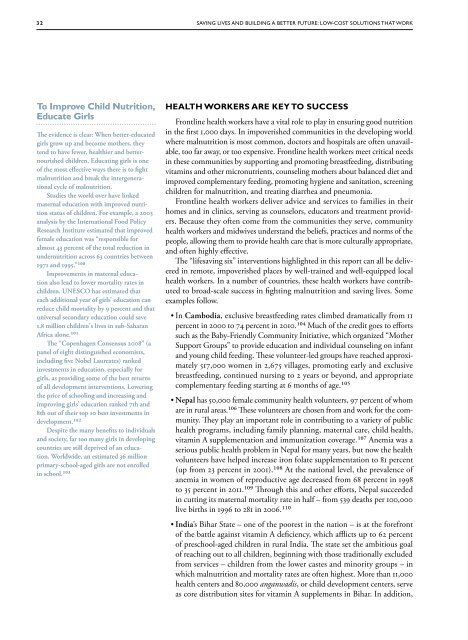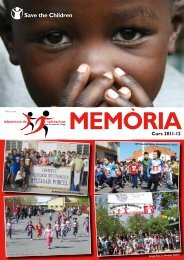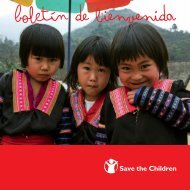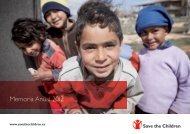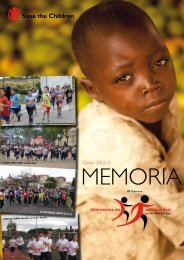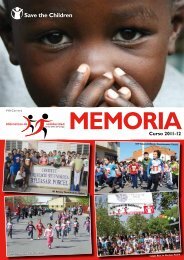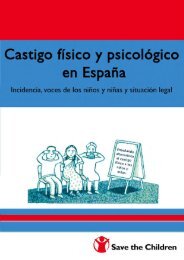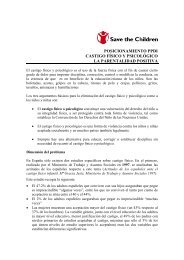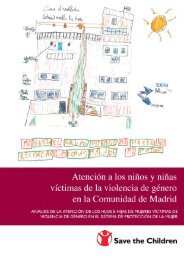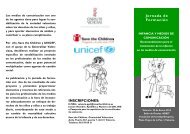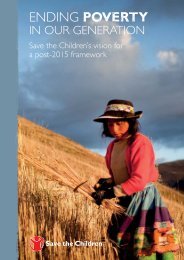Nutrition in the First 1,000 Days - Save the Children
Nutrition in the First 1,000 Days - Save the Children
Nutrition in the First 1,000 Days - Save the Children
Create successful ePaper yourself
Turn your PDF publications into a flip-book with our unique Google optimized e-Paper software.
32 SaviNg liveS aND BUilDiNg a Better FUtUre: loW-coSt SolUtioNS that WorK<br />
to improve improve Child nutrition,<br />
educate girls<br />
The evidence is clear: When better-educated<br />
girls grow up and become mo<strong>the</strong>rs, <strong>the</strong>y<br />
tend to have fewer, healthier and better-<br />
nourished children. Educat<strong>in</strong>g girls is one<br />
of <strong>the</strong> most effective ways <strong>the</strong>re is to fight<br />
malnutrition and break <strong>the</strong> <strong>in</strong>tergenera-<br />
tional cycle of malnutrition.<br />
Studies <strong>the</strong> world over have l<strong>in</strong>ked<br />
maternal education with improved nutri-<br />
tion status of children. For example, a 2003<br />
analysis by <strong>the</strong> International Food Policy<br />
Research Institute estimated that improved<br />
female education was “responsible for<br />
almost 43 percent of <strong>the</strong> total reduction <strong>in</strong><br />
undernutrition across 63 countries between<br />
1971 and 1995.” 1995.”100 100<br />
Improvements <strong>in</strong> maternal educa-<br />
tion also lead to lower mortality rates <strong>in</strong><br />
children. UNESCO has estimated that<br />
each additional year of girls’ education can<br />
reduce child mortality by 9 percent and that<br />
universal secondary education could save<br />
1.8 million children's lives <strong>in</strong> sub-Saharan<br />
Africa alone. alone.101 101<br />
The “Copenhagen Consensus 2008” (a<br />
panel of eight dist<strong>in</strong>guished economists,<br />
<strong>in</strong>clud<strong>in</strong>g five Nobel Laureates) ranked<br />
<strong>in</strong>vestments <strong>in</strong> education, especially for<br />
girls, as provid<strong>in</strong>g some of <strong>the</strong> best returns<br />
of all development <strong>in</strong>terventions. Lower<strong>in</strong>g<br />
<strong>the</strong> price of school<strong>in</strong>g and <strong>in</strong>creas<strong>in</strong>g and<br />
improv<strong>in</strong>g girls’ education ranked 7th and<br />
8th out of <strong>the</strong>ir top 10 best <strong>in</strong>vestments <strong>in</strong><br />
development.<br />
development.102 102<br />
Despite <strong>the</strong> many benefits to <strong>in</strong>dividuals<br />
and society, far too many girls <strong>in</strong> develop<strong>in</strong>g<br />
countries are still deprived of an educa-<br />
tion. Worldwide, an estimated 36 million<br />
primary-school-aged girls are not enrolled<br />
<strong>in</strong> school. school.103 103<br />
heaLth woRKeRs aRe Key to sUCCess<br />
Frontl<strong>in</strong>e health workers have a vital role to play <strong>in</strong> ensur<strong>in</strong>g good nutrition<br />
<strong>in</strong> <strong>the</strong> first 1,<strong>000</strong> days. In impoverished communities <strong>in</strong> <strong>the</strong> develop<strong>in</strong>g world<br />
where malnutrition is most common, doctors and hospitals are often unavailable,<br />
too far away, or too expensive. Frontl<strong>in</strong>e health workers meet critical needs<br />
<strong>in</strong> <strong>the</strong>se communities by support<strong>in</strong>g and promot<strong>in</strong>g breastfeed<strong>in</strong>g, distribut<strong>in</strong>g<br />
vitam<strong>in</strong>s and o<strong>the</strong>r micronutrients, counsel<strong>in</strong>g mo<strong>the</strong>rs about balanced diet and<br />
improved complementary feed<strong>in</strong>g, promot<strong>in</strong>g hygiene and sanitation, screen<strong>in</strong>g<br />
children for malnutrition, and treat<strong>in</strong>g diarrhea and pneumonia.<br />
Frontl<strong>in</strong>e health workers deliver advice and services to families <strong>in</strong> <strong>the</strong>ir<br />
homes and <strong>in</strong> cl<strong>in</strong>ics, serv<strong>in</strong>g as counselors, educators and treatment providers.<br />
Because <strong>the</strong>y often come from <strong>the</strong> communities <strong>the</strong>y serve, community<br />
health workers and midwives understand <strong>the</strong> beliefs, practices and norms of <strong>the</strong><br />
people, allow<strong>in</strong>g <strong>the</strong>m to provide health care that is more culturally appropriate,<br />
and often highly effective.<br />
The “lifesav<strong>in</strong>g six” <strong>in</strong>terventions highlighted <strong>in</strong> this report can all be delivered<br />
<strong>in</strong> remote, impoverished places by well-tra<strong>in</strong>ed and well-equipped local<br />
health workers. In a number of countries, <strong>the</strong>se health workers have contributed<br />
to broad-scale success <strong>in</strong> fight<strong>in</strong>g malnutrition and sav<strong>in</strong>g lives. Some<br />
examples follow.<br />
• In Cambodia, exclusive breastfeed<strong>in</strong>g rates climbed dramatically from 11<br />
percent <strong>in</strong> 2<strong>000</strong> to 74 percent <strong>in</strong> 2010.104 Much of <strong>the</strong> credit goes to efforts<br />
such as <strong>the</strong> Baby-Friendly Community Initiative, which organized “Mo<strong>the</strong>r<br />
Support Groups” to provide education and <strong>in</strong>dividual counsel<strong>in</strong>g on <strong>in</strong>fant<br />
and young child feed<strong>in</strong>g. These volunteer-led groups have reached approximately<br />
517,<strong>000</strong> women <strong>in</strong> 2,675 villages, promot<strong>in</strong>g early and exclusive<br />
breastfeed<strong>in</strong>g, cont<strong>in</strong>ued nurs<strong>in</strong>g to 2 years or beyond, and appropriate<br />
complementary feed<strong>in</strong>g start<strong>in</strong>g at 6 months of age.105<br />
• Nepal has 50,<strong>000</strong> female community health volunteers, 97 percent of whom<br />
are <strong>in</strong> rural areas.106 These volunteers are chosen from and work for <strong>the</strong> community.<br />
They play an important role <strong>in</strong> contribut<strong>in</strong>g to a variety of public<br />
health programs, <strong>in</strong>clud<strong>in</strong>g family plann<strong>in</strong>g, maternal care, child health,<br />
vitam<strong>in</strong> A supplementation and immunization coverage.107 Anemia was a<br />
serious public health problem <strong>in</strong> Nepal for many years, but now <strong>the</strong> health<br />
volunteers have helped <strong>in</strong>crease iron folate supplementation to 81 percent<br />
(up from 23 percent <strong>in</strong> 2001).108 At <strong>the</strong> national level, <strong>the</strong> prevalence of<br />
anemia <strong>in</strong> women of reproductive age decreased from 68 percent <strong>in</strong> 1998<br />
to 35 percent <strong>in</strong> 2011.109 Through this and o<strong>the</strong>r efforts, Nepal succeeded<br />
<strong>in</strong> cutt<strong>in</strong>g its maternal mortality rate <strong>in</strong> half – from 539 deaths per 100,<strong>000</strong><br />
live births <strong>in</strong> 1996 to 281 <strong>in</strong> 2006.110<br />
• India’s Bihar State – one of <strong>the</strong> poorest <strong>in</strong> <strong>the</strong> nation – is at <strong>the</strong> forefront<br />
of <strong>the</strong> battle aga<strong>in</strong>st vitam<strong>in</strong> A deficiency, which afflicts up to 62 percent<br />
of preschool-aged children <strong>in</strong> rural India. The state set <strong>the</strong> ambitious goal<br />
of reach<strong>in</strong>g out to all children, beg<strong>in</strong>n<strong>in</strong>g with those traditionally excluded<br />
from services – children from <strong>the</strong> lower castes and m<strong>in</strong>ority groups – <strong>in</strong><br />
which malnutrition and mortality rates are often highest. More than 11,<strong>000</strong><br />
health centers and 80,<strong>000</strong> anganwadis, or child development centers, serve<br />
as core distribution sites for vitam<strong>in</strong> A supplements <strong>in</strong> Bihar. In addition,


